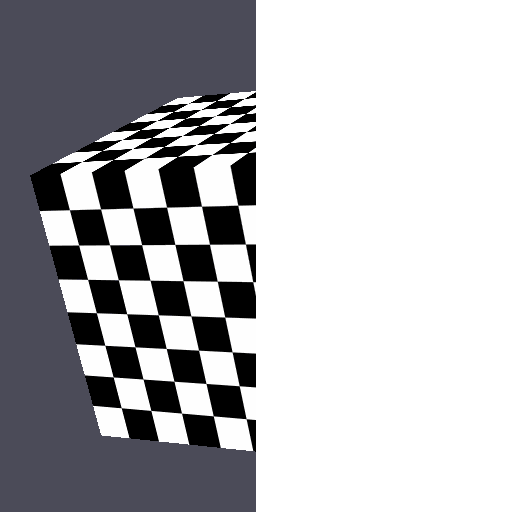Note
Go to the end to download the full example code.
Show post-processing using a FrameBuffer#

/home/runner/work/vispy/vispy/examples/gloo/post_processing.py:84: DeprecationWarning: `row_stack` alias is deprecated. Use `np.vstack` directly.
Z = np.row_stack(grid_num // 2 * (row_even, row_odd)).astype(np.uint8)
import numpy as np
from vispy import app
from vispy.geometry import create_cube
from vispy.util.transforms import perspective, translate, rotate
from vispy.gloo import (Program, VertexBuffer, IndexBuffer, Texture2D, clear,
FrameBuffer, RenderBuffer, set_viewport, set_state)
cube_vertex = """
uniform mat4 model;
uniform mat4 view;
uniform mat4 projection;
attribute vec3 position;
attribute vec2 texcoord;
attribute vec3 normal; // not used in this example
attribute vec4 color; // not used in this example
varying vec2 v_texcoord;
void main()
{
gl_Position = projection * view * model * vec4(position,1.0);
v_texcoord = texcoord;
}
"""
cube_fragment = """
uniform sampler2D texture;
varying vec2 v_texcoord;
void main()
{
float r = texture2D(texture, v_texcoord).r;
gl_FragColor = vec4(r,r,r,1);
}
"""
quad_vertex = """
attribute vec2 position;
attribute vec2 texcoord;
varying vec2 v_texcoord;
void main()
{
gl_Position = vec4(position, 0.0, 1.0);
v_texcoord = texcoord;
}
"""
quad_fragment = """
uniform sampler2D texture;
varying vec2 v_texcoord;
void main()
{
vec2 d = 5.0 * vec2(sin(v_texcoord.y*50.0),0)/512.0;
// Inverse video
if( v_texcoord.x > 0.5 ) {
gl_FragColor.rgb = 1.0-texture2D(texture, v_texcoord+d).rgb;
} else {
gl_FragColor = texture2D(texture, v_texcoord);
}
}
"""
def checkerboard(grid_num=8, grid_size=32):
row_even = grid_num // 2 * [0, 1]
row_odd = grid_num // 2 * [1, 0]
Z = np.row_stack(grid_num // 2 * (row_even, row_odd)).astype(np.uint8)
return 255 * Z.repeat(grid_size, axis=0).repeat(grid_size, axis=1)
class Canvas(app.Canvas):
def __init__(self):
app.Canvas.__init__(self, title='Framebuffer post-processing',
keys='interactive', size=(512, 512))
# Build cube data
# --------------------------------------
vertices, indices, _ = create_cube()
vertices = VertexBuffer(vertices)
self.indices = IndexBuffer(indices)
# Build program
# --------------------------------------
view = translate((0, 0, -7))
self.phi, self.theta = 60, 20
model = rotate(self.theta, (0, 0, 1)).dot(rotate(self.phi, (0, 1, 0)))
self.cube = Program(cube_vertex, cube_fragment)
self.cube.bind(vertices)
self.cube["texture"] = checkerboard()
self.cube["texture"].interpolation = 'linear'
self.cube['model'] = model
self.cube['view'] = view
color = Texture2D((512, 512, 3), interpolation='linear')
self.framebuffer = FrameBuffer(color, RenderBuffer((512, 512)))
self.quad = Program(quad_vertex, quad_fragment, count=4)
self.quad['texcoord'] = [(0, 0), (0, 1), (1, 0), (1, 1)]
self.quad['position'] = [(-1, -1), (-1, +1), (+1, -1), (+1, +1)]
self.quad['texture'] = color
# OpenGL and Timer initalization
# --------------------------------------
set_state(clear_color=(.3, .3, .35, 1), depth_test=True)
self.timer = app.Timer('auto', connect=self.on_timer, start=True)
self._set_projection(self.physical_size)
self.show()
def on_draw(self, event):
with self.framebuffer:
set_viewport(0, 0, 512, 512)
clear(color=True, depth=True)
set_state(depth_test=True)
self.cube.draw('triangles', self.indices)
set_viewport(0, 0, *self.physical_size)
clear(color=True)
set_state(depth_test=False)
self.quad.draw('triangle_strip')
def on_resize(self, event):
self._set_projection(event.physical_size)
def _set_projection(self, size):
width, height = size
set_viewport(0, 0, width, height)
projection = perspective(30.0, width / float(height), 2.0, 10.0)
self.cube['projection'] = projection
def on_timer(self, event):
self.theta += .5
self.phi += .5
model = rotate(self.theta, (0, 0, 1)).dot(rotate(self.phi, (0, 1, 0)))
self.cube['model'] = model
self.update()
if __name__ == '__main__':
canvas = Canvas()
app.run()
Total running time of the script: (0 minutes 1.074 seconds)
